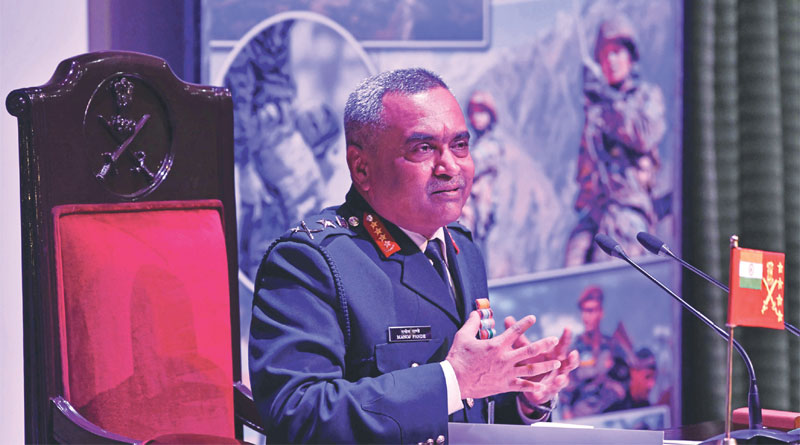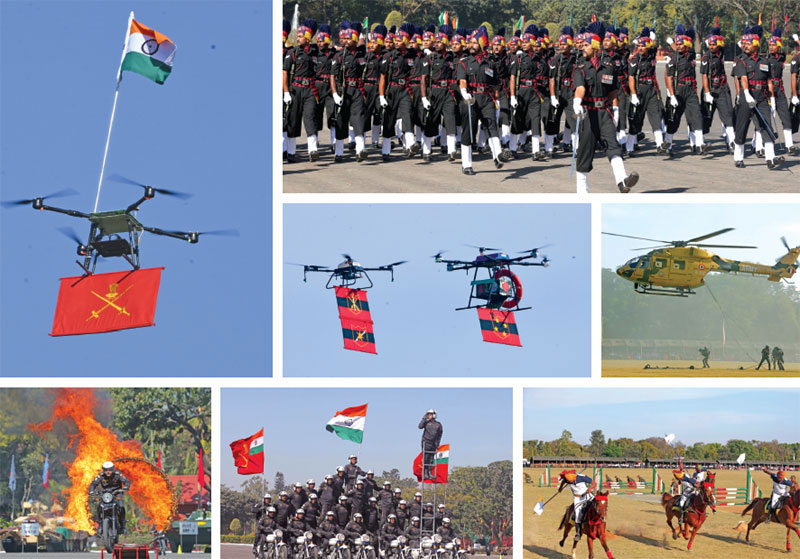General Pande says Agnipath scheme, modernisation & rightsizing are top priorities
Smruti Deshpande
In his first press conference, Chief of the Army Staff General Manoj Pande summed up the major events since the time he assumed office and termed the past eight months as “extremely satisfying and fulfilling.” A special mention went to the Agnipath reform. “Agnipath, or the new human resource management philosophy, was an important component,” he said.

Speaking about the situation in the neighbourhood, he mentioned the line of actual control (LAC) as well as the line of control (LoC). “In the immediate neighbourhood, there are security challenges. Regarding the situation on the northern borders, I would say the situation is stable, under control, yet unpredictable,” he said.
He added that in the ongoing talks between India and China, the two sides had been able to resolve five of the seven issues that were on the table and that the two countries continue to talk at the diplomatic and military levels. In terms of our preparedness, he said, “We have adequate forces and reserves in each of our sectors to deal effectively with any situation or contingency. You are also aware of the strategic reorientation that we undertook sometime back. It is complete in every respect.”
According to the COAS, the ceasefire in Jammu and Kashmir between India and Pakistan, which came about in February 2021, was holding well. “Cross-border support for terrorism and terrorist infrastructure, however, remains,” he said. “In the hinterland itself we have seen some proxy tanzims which have been indulging in activities and acts purely with a view to gain visibility and remain in the news,” he added. General Pande said people of J&K were partnering with the government in a number of development initiatives. “All this notwithstanding, we need to remain alert both on the LoC insofar as infiltration goes and the hinterland,” he said.
Regarding intrusions, he said in 2022 infiltration had gone down. In J&K only 12 infiltration attempts had taken place and 18 intruders had been killed. “India’s anti-infiltration grid in the valley is strong and that’s why the adversary has been focused on the south of Pir Panjal, especially in Jammu, Punjab and near the international border. We have seen a number of instances wherein with the use of drones, they have sent in weapons, ammunition and explosives. But the army and the BSF have together stalled their actions. In regard to this, the army is using drone jammers and spoofers. The efficacy of this technology, as per reports, is good.”
In the northeast, peace had returned in most of the states. In General Pande’s view, economic activity and development initiatives had yielded good returns and over all the dividends of peace were clearly evident.
Summing the border situation, he said, “I am happy to say that along the LoC, the LAC and the hinterland, our soldiers have maintained operational readiness. My focus has also been on modernisation and technology infusion. They are the pillars of transformation that we are seeking to undertake.”
“We have decided to undertake transformation of the army starting from force restructuring and optimisation, modernisation and technology infusion and human resource management philosophy or Agnipath,” he said. Rightsizing was one of the most important factors on the army’s mind.
“We are also looking at better outcomes in terms of jointness and integration. Lastly, we are refining and improving our systems and processes in order to enhance the operational, administrative as well as the logistic efficiencies,” the army chief said. On human resources, he said the army plans to commission women officers in the artillery regiment. The proposal had been forwarded to the government. Speaking about technology, he said the limitless potential of disruptive technologies had come of age.
Regarding procurements, he said, “We are looking at six lakh weapons which will be manufactured in collaboration with the Russians and as per the contract, this is to happen over a period of 128 months or close to 10 years. Roughly 70,000 AK-203 rifles will be produced in 32 months. The indigenous content is required to be in the range of 5 to 70 per cent. After the initial 70,000, you will have a completely indigenous AK-203 rifle. The IRRPL will deliver the first 5,000 AK-203s by March this year.”

On China’s massive infrastructure build-up along the LAC, he said “this is a very important topic. What you hear and what the narrative (in general) is that there is a lot of infrastructure building happening on the other side of the LAC. But what does not come to the fore is what has happened on our side.”
In the last five years, the Border Roads Organisation (BRO) had constructed 6,000 km of roads pan India out of which 2,100 km was along the northern border. Bridges had been upgraded and close to 7,450 metres of bridges were constructed by the BRO. He said funds for 1,800 kms of highways in Arunachal Pradesh had been allocated. “Some work regarding the highway was already underway, but this has got an impetus,” General Pande said.
“There is an aspect of all-weather connectivity, especially in forward areas. I am referring to Ladakh and Kameng of Arunachal Pradesh. In Ladakh, there is the Zoji La tunnel and the Z-Morh tunnel which will link the Kashmir Valley to Ladakh. It will be ready by the end of the year,” he said.
“While the Atal tunnel is well known, we also have the Shinkun La tunnel along the Nimu-Padum-Darcha road, which again is in the final stages of approval. Once this happens, you will have all-weather connectivity from both sides to Ladakh. There is also better connectivity to the Kameng sector or the Tawang sector wherein you have the Sena tunnel, which is likely to get operationalised by the middle of this year, as well as one from the South at a place called Nechiphu near Bomdila.” He said these were the two tunnels in the eastern sector which will provide all-weather connectivity. “Bridges are coming up on the Brahmaputra river. There are five major crossing places and there are more which the BRO and NHIDCL are planning,” he said.
He said, “If I were to count the strategic railway lines, there are four which are planned. Three are in the northeast and one in the Ladakh sector. The alignment and the final location have been completed. The issue of the source of funding is under discussion.”
“Regarding habitats in eastern Ladakh, in the last two years habitats for close to 55,000 troops have been completed. There is also covered and heated accommodation for 300-400 guns and about 500-odd vehicles such as tanks and BMPs,” General Pande said. Overall, Rs 1,300 crore had been spent in the last three years on infrastructure and habitat requirements in Ladakh.
Along the northern border, the deployment from the adversary’s side continued in the same manner and India had an equal number of troops. “In terms of numbers, there has been a slight increase in the number of troops in the east but we are keeping a close watch on their movements and activities,” he said.
Regarding the army’s arms, 45 per cent were vintage, 41 per cent were current and 12-15 per cent state-of-the-art. “By 2030, the army will reach close to 35 per cent current and 44 per cent state-of-the-art through modernisation,” General Pande said. “How do we integrate the legacy systems with future systems? One method is to upgrade. Our existing tanks, artillery gun systems and electronic warfare systems are being upgraded,” he added.
“We have also decided that the year 2023 will be a year of transformation. We have laid out a roadmap and we intend to meet the outcomes. Of course, this process will continue beyond the current year. This army day is also special in the sense that this is also the 75th year of Independence.” He said besides carrying out its primary mandate and role, the Indian Army was fully aligned to the national vision and committed to achieving national goals and objectives.

